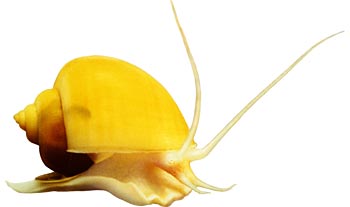
(Reeve, 1856)
Synonym (obsolete): Ampullarius australis, Pomacea bridgesii diffusa
 |
(Reeve, 1856) Synonym (obsolete): Ampullarius australis, Pomacea bridgesii diffusa
|
Pomacea bridgesii (Reeve, 1856) and
Pomacea diffusa (Blume, 1957) have long been considered to be a single species.
Nowadays, they are considered to be distinct species based on mitochondrial
DNA analysis. Pomacea bridgesii (Reeve,
1856) is a rather rare species that is known to inhabit a small range: the Rio
Grande, Reyes River at Beni (bridges). Pomacea diffusa (Blume, 1957)
is much more common and inhabits almost the entire Amazon river system. It's
also the latter that is common in the aquarium trade.
Pomacea bridgesii is rather large (65mm shell height and more), while
Pomacea diffusa is much smaller, has a much more pronounced spire and
a darker shell colour.
Shell: The shell of this apple snails
species has about 5 to 6 whorls. The most obvious characteristic of the shell
are the square shoulders (flat at the top of the whorls) and almost 90°
sutures. The shell opening (aperture) is large and oval, the umbilicus is
large and deep.
The size of the shell varies from 40-50 mm wide and 45-65 mm high. The spire
is high and sharp, hance the often used name: spike-topped apple snail.
The colour varies from yellow, green to brown, with or without dark spiral bands
(a lot of variations exists). Due to cultivated mutations white and blue variations
are obtained in recent years. The yellow variation is well known in the aquarium
trade as the golden mystery snail. This variation was originally generated
in Florida (U.S.A.) and has then spread in the aquarium trade. The white variations
are sometimes called the ivory snail in the aquarium world.
![]() 'Shell
colour genes' section (interactive page to learn more about the colour genes
in Pomacea diffusa.
'Shell
colour genes' section (interactive page to learn more about the colour genes
in Pomacea diffusa.
|
Interactive 3D-models (Java): |
Operculum: The operculum is moderately thick and corneous. The structure
is concentric with the nucleus near the centre of the shell. The colour of the
operculum varies from light to dark brown. The operculum can be retracted in
the aperture (shell opening).
Body: As with the shell, many variations exist: from light yellow (cultivated)
to almost black with yellow spots on the mouth.
|
|
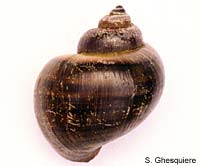 Shell of a dark wild-form Pomacea diffusa snail, back view. |
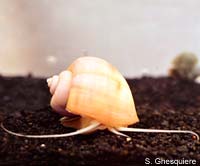 Almost white variant of Pomacea diffusa, also called the ivory snail. |
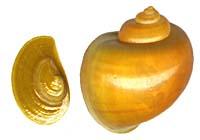 Shell and operculum, young snail. Note the 90° sutures and flat upper part of the whorls, typical of Pomacea diffusa. |
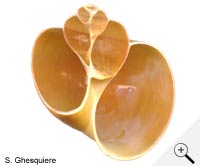 Shell of Pomacea diffusa, view of the inside to illustrate the shell construction. |
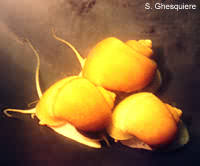 Pomacea diffusa, yellow (golden) variant. Note the flat top of the whorls. |
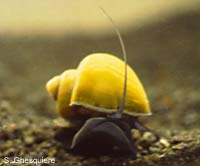 Yellow-black apple snail (Pomacea diffusa. This colour variant lacks the brown colour of the shell, so the yellow base colour shines through. |
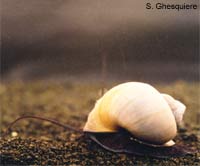 Blue apple snail (Pomacea diffusa). The shell is in fact white, but the black body of the snail shines through as blue. |
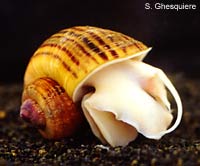 Pomacea diffusa variant with banded (brown) shell. |
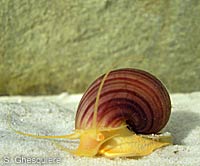 Red-yellow variety of Pomacea diffusa. This colour variant lacks the yellow base colour of the shell, so the purple-reddish bands are left without their yellow pigment, which normally makes the brown. |
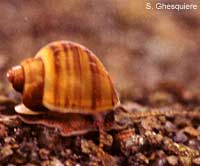 Pomacea diffusa, wildtype colours. |
Eggs: The pale pink to reddish eggs are deposited above the waterline and are closely attached to each other. Their size varies from 2.20 to 3.5 mm (0.5 to 0.9 inch) diameter. An average egg-clutch contains 200 to 600 eggs.
|
|
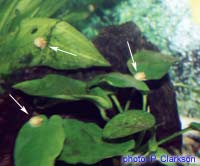 Young Pomacea diffusa snails. (picture not licenced under creative commons) |
Food: Prefers dead and rotting plants and artificial foods like fish
food; doesn't eat healthy plants unless no other food is available. This makes
the Pomacea diffusa snail a good choice for planted aquaria.
Behaviour: moderately amphibious animal; relatively inactive during the
day; can often be found on the bottom where it's searching for food or remains
hidden in the mud; most activity during the night.
Distribution: Pomacea diffusa: Widely distributed throughout the Amazon
river system (Bolivia, Brazil, Paraguay and Peru). Pomacea bridgesii:
rare species only reported at Rio Grande, Reyes River at Beni.
In the 1960s Pomacea diffusa has been introduced to Hawaii and in the
1980s it has spread to south-east Asia. In the early 1980's Pomacea diffusa
established in Florida, USA.
Common in the aquarium trade, especially the yellow variation.
Similar to: Pomacea diffusa looks similar to more Pomacea scalaris
and Pomacea bridgesii to which it's
probably close related to. In Pomacea scalaris,
the shell shoulder is much more angulated, in such extent that it almost carinated.
Pomacea scalaris lives more to the
south (Argentina and South Brasil). However Reeve (1856) described Bolivia as
habitat of Pomacea scalaris as well.